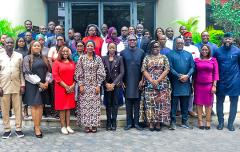Five hurdles to getting productive use of energy products to the last mile
By: Emma Colenbrander, Head of the Global Distributors Collective (GDC); Yasemin Erboy Ruff, Clean Energy Access Manager at CLASP; Chris Beland, Technical Programme Manager at Energy Saving Trust (EST)
Productive use of energy (PUE) technologies cover a broad spectrum of energy-enabled products that improve livelihoods when used by customers to generate additional – or new – sources of income. PUE is gaining increasing attention from companies and funders alike. But going beyond pilots to meaningfully sell PUE products, and ensuring that last mile consumers can afford them and realize productivity gains, is complex.
This blog explores the top challenges that need overcoming to effectively sell PUE products, and how distributors are working to overcome them. It is based on insights from the Global Distributors Collective (GDC)’s recent report on Lessons Learned Selling PUE Products to Last Mile Consumers, and learnings from the Efficiency for Access Coalition’s experience over the last five years promoting high-performing solar appliances.
Just like in the pay-as-you-go solar home system market, the ‘unbundling’ of PUE value chains is beginning to drive increased participation of smaller, as well as local, companies in the sector. This is demonstrated by the significant increase in the number of last mile distributors selling PUE products in recent years.
Between 2019 and 2022, the number of GDC members who reported selling these products rose from 6 percent to 35 percent. Interest in PUE has been driven by continuous improvements in the durability, affordability, and performance of maturing product categories such as solar fridges and water pumps; high consumer demand and impact potential; innovation in areas such as consumer financing; and the need for companies to sell higher margin products, and upsell to existing customers, to attain profitability.
However, selling PUE products tends to be much more complex than selling off-grid lighting and basic appliances like TVs and fans. GDC members consistently report that they underestimated how hard it would be to sell PUE products – particularly those related to agriculture, like solar water pumps, agri-processing equipment, solar egg incubators and fridges/freezers – and that while the demand is often there, they have not yet been able to effectively meet that demand.
This reflects the experience of companies supported by the Efficiency for Access Coalition (EforA). In 2021, for example, EforA ran a solar water pump consumer awareness campaign in Kenya which generated over 100 leads but, to date, no leads have been converted to sales; in many cases due to companies’ limited bandwidth to follow up with customers and a lack of financing options.
The GDC and EforA have identified five key challenges that still need to be overcome for effective last mile distribution of PUE products.
1. Many product categories are not yet market-ready and still have underdeveloped supply chains.
This makes it hard to identify and procure appropriate, affordable products from suppliers that are able to provide distributors with a stable supply chain and the support they need around training, marketing, and after-sales service. It also means that distributors are having to invest substantial resources in R&D and generating market feedback, but this role is rarely recognized or valued.
As Solar Sister in Tanzania put it, “Manufacturers are still in a product development mindset – they aren’t thinking yet about the realities of marketing, selling, and after-sales service. Last mile distribution is not about just putting out a technically correct product, but also a sellable product. We are expected to figure out everything around the product - the market, the sales process, the financing - but with zero R&D support. It’s just not realistic”.
2. Deep market research is essential to understand not only consumer needs and willingness to pay, but also agricultural market systems, and social and gender dynamics related to PUE products.
For example, Sumba Sustainable Solutions in Indonesia found that women can be perceived as lazy if they don’t do washing by hand, and that communal washing at the river is an important social ritual, which meant demand for solar washing machines was lower than anticipated.
In Senegal, Nadji.Bi developed and are providing a solar milling service as part of a broader hub model. From the outset, they involved women’s groups in the design and development of this new hub. As a result of the women's feedback, Nadji.Bi included additional services such as refrigerators or phone charging, in the hub, which has seen all households within a 1km radius of the hub use it.
3. Affordability is a major barrier, but providing consumer financing is far from straightforward due to the complexity of credit risk management and high working capital requirements.
A handful of distributors have been able to outsource consumer financing to a third-party MFI or bank, or to PUE suppliers. The majority manage financing in-house and have adopted a range of strategies to diversify payment options.
For example, SolarWorks in Mozambique offers seasonal payment plans, while Village Infrastructure Angels (VIA) in the Indo-Pacific and Natfort Energy in Zimbabwe accept non-cash payments: “We ask customers: how much time are our products [agri-processing equipment] saving you, and can you make something with that time that we can barter? We have bought mats, handwoven baskets and jewellery from customers to sell”. Some distributors such as Sosai in Nigeria have adopted service models (i.e., perpetual lease models) for PUE products like solar dryers, but these are still early-stage pilots.
4. The technical complexity of PUE products creates challenges in terms of customization, professional installation, end-user education and after-sales service.
Distributors need to provide more extensive technical training for their entrepreneurs/agents, who then provide that training to customers, but effectively communicating this level of information can be challenging.
For example, customer surveys undertaken by EforA in Kenya found that customers struggled to understand the various performance and sizing factors of different solar water pumps. One farmer said that, despite having an engineering background, he ended up buying a pump that was not ideal for his needs, and if he could do it over again with the knowledge he now has, he would have chosen a different one.
After-sales service is also more complex and intensive with PUE products, and distributors report receiving a higher volume of customer calls about PUE products than other beneficial products they sell. However, with many PUE suppliers not being local, it can be difficult to work out how to repair or replace products in a timely manner and who will do this and bear the cost. Some distributors have managed these challenges by building specialized sales teams for different PUE products, such as SolarWorks having specialist irrigation and refrigeration teams.
5. PUE products often need to be accompanied by additional customer support, such as business advisory support and market linkages.
The pioneers when it comes to market linkages are specialist companies in the cold storage space, such as Adili Solar Hubs in Kenya, which EforA has supported through its R&D Fund.
Distributors have not historically provided this kind of support, but many are finding that doing so is necessary to help customers maximise productivity gains from PUE products. For example, Mwezi in Kenya is helping customers that have purchased solar egg incubators to connect with other actors along the poultry value chain, such as buyers of chicks and input providers.
But this kind of support has not been systematic, and it does not seem feasible for distributors to play this role moving forward. Partnerships with aggregators and off-takers make more sense, although this is not straightforward. As EnerGrow has found, “We’re building partnerships with FAO and an agri-input company, but neither of these organisations currently work with off-takers, so making these partnerships work will take a lot of time and energy.”
To accelerate the unbundling of PUE value chains and unlock a wave of PUE market growth:
- Distributors need to start small and invest in market research before undertaking field tests of PUE products. This will enable them to learn as much as possible about customer needs, products and suppliers, sales, consumer financing and after-sales strategies, as well as agricultural market systems more broadly, before scaling up.
- Suppliers can help by investing time in building strong partnerships with distributors, making sure both parties are clear on roles and responsibilities, and being responsive to customer and distributor feedback. While suppliers cannot do it all, they can help distributors build their capabilities to sell PUE products by supporting agent/entrepreneur training, marketing and after-sales service efforts.
- Donors, programme implementers and investors can help by generating and sharing reliable third-party information about products and suppliers. They can also provide grant funding and technical assistance for distributors to run small-scale pilots and build their capabilities to sell PUE products, as well as build consumer financing strategies to maximise affordability.
For more information and insights, please see the GDC’s report: Lessons Learned Selling Productive Use of Energy Products to Last Mile Consumers, which was financed by EEP Africa in partnership with Solar Sister.
Image credit: Efficiency for Access/Story by Design




